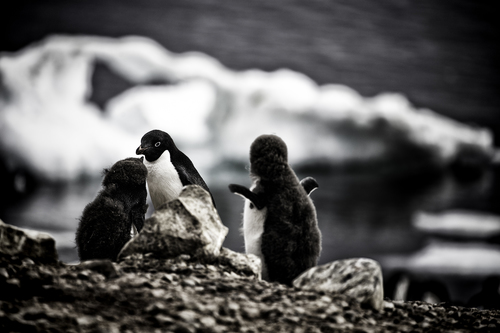The excursion this morning has been through the Antarctic Sound on our way to Brown Bluff, our first landfall on the Antarctic Continent. As the Sea Explorer powers towards our disembarkation site, we're blessed with viewing multiple tabular icebergs along the way in beautiful morning light.
Brown Bluff is a basalt tuya, the geologic description given to a distinctive, flat-topped, steep-sided volcano formed when lava erupts through a thick glacier or ice sheet. Located on the Tabarin Peninsula of northern Antarctica, this butte formed within the past 1 million years due to a subglacial eruption within an englacial lake. Originally thought to have been 12-15 kilometers in diameter, Brown Bluff got its name from the brown-to-black hyaloclastite that gives it a distinctive hue.
As our zodiac heads towards shore, we're greeted by several hundred gentoos, with up to 20,000 adélie penguins lining the beachfront. Landing is made on a long cobble and ash seafront that rises steeply towards red-brown tuff cliffs. Embedded with tephra, or volcanic material ejected during an eruption, I start to see heavily eroded precipices of scree, or the detritus that has accumulated from rocks having fallen from higher slopes. Numerous large, wind eroded boulders catch my eye, lying sporadically on the shore. Tidewater glaciers surround us to the north and south as small, floating fragments of sea ice wash up to the brim of our landing site.
Having just come from South Georgia Island and the Falklands, I'm struck by the lack of vegetation in front of me. Our geologic guide informs us that only lichens, mosses and algae can grow in this harsh environment. A kelp gull colony lines the boulder area that extends south-southeast behind the moraine ridge, a mass of unstratified glacial drift. Snow petrel nests are also seen behind the penguin rookeries that populate the seafront. As I walk along the snow slope to the east of the landing beach, I take special care to avoid skua nests on the ground. These are large brown gull-like predatory birds seen gliding along the coast.
Touring along this amazing landscape, I now have a close up view of the Brown Bluff Volcano. Formed during the Pleistocene era, this is a shallow water, alkali basaltic structure whose deposits were ponded within a lake that was enclosed by ice greater than 400 meters thick. While contemplating the enormity of this eminence, my concentration is interrupted by hordes of penguins and Weddell seals I hear grunting along the seashore.
Cruising slowly along the beach, the penguin show is spectacular. A rookery of adélies amuses me as I see them interacting with each other. These birds are considered in the "near threatened" category, living mostly on the Antarctic continent and on many small, surrounding coastal islands. During the winter months, they depart to the offshore seas that surround the Antarctic pack ice.
The adélies are carnivores, feeding on tiny aquatic creatures such as shrimp-like krill. Fish and squid are also menu items for these flightless, aquatic birds that dive up to 575 feet in search of food. Sleek and efficient swimmers, they have been known to travel a distance approaching 185 miles round trip to procure a meal.
Progressing slowly, I skirt this colony of adélies, watching them building their nests. They appear to move quite slowly, ambulating with a distinctive "penguin waddle." I'm told not to be deceived by this pace as they can walk up to 31 miles from their onshore nests to reach open water in the early spring, before the vast ice sheets begin to dissolve.
Our morning's activities are drawing to a close. I've come to realize how little I know about geology and ornithology, 2 disciplines that our guides are expert in. Despite this knowledge gap, I've had great fun photographing this habitat and look forward to post processing and printing some of my photos. I'll have plenty of time to read up on everything I've seen after I return home from this trip.





